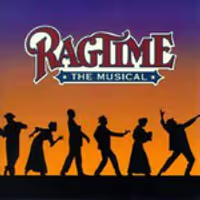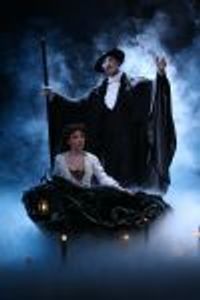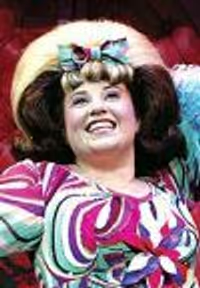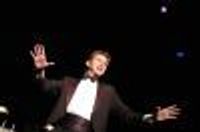POTO Chandelier Article
#1POTO Chandelier Article
Posted: 6/23/07 at 9:55am
There's an interesting bit about The Phantom of The Opera on washingtonpost.com that explains the mechanics that are involved with the Chandelier rise and descent during the show. Although I'm sure a lot of people here already knew how it was done, I thought I'd post it anyway.
I thought it was kinda interesting
'Phantom" Menace? Don't Believe Your Eyes
Broadway Legend Joined: 12/31/69
#2re: POTO Chandelier Article
Posted: 6/23/07 at 10:17am
Five seconds for the fall, huh?
I wonder if anyone here can attest to the theory that the chandeliers in London or anywhere else fall faster than the ones in the US. When I saw it last week in the orchestra, I had time to look up at it, look to person next to me, exchange a glance of "wow, that's slow", and look up again... and the darn thing still hadn't hit.
#2re: POTO Chandelier Article
Posted: 6/23/07 at 10:20amThank you for sharing that article....I found it interesting!
#3re: POTO Chandelier Article
Posted: 6/23/07 at 10:47amI've only seen it on B'way but it definitely didn't impress me as much as it did when I was 12!
#4re: POTO Chandelier Article
Posted: 6/23/07 at 11:21am
I've heard that the one on Broadway falls really slow. Apparently the touring one goes a little faster. I can't compare cause I haven't seen it on Broadway and I'll actually be seeing it for the first time at the Kennedy Center in July.
#5re: POTO Chandelier Article
Posted: 6/23/07 at 12:18pmApparently the Australian chandelier fell the fastest of them all, we'll soon find out!
Rotel1026
Broadway Star Joined: 8/12/06
#6re: POTO Chandelier Article
Posted: 6/23/07 at 12:39pmI've not seen it in Vegas but prior to it opening in Vegas, there were articles mentioning how spectacular that chendelier would be. Apparently it starts off in 10 (?) different pieces circling around each other and assembling themselves into the full size chandelier and then falling pretty fast. Honestly, the only reason I want to see Phantom in Vegas if for the chandelier.
#8re: POTO Chandelier Article
Posted: 6/23/07 at 2:56pmThe Vegas chandelier is completely different from any other company's. It uses state of the art technology that obviously was not available in the late 80s when the standard chandelier was designed.
#9re: POTO Chandelier Article
Posted: 6/23/07 at 2:58pm
Very cool! thanx for sharing
#10re: POTO Chandelier Article
Posted: 6/23/07 at 3:05pmI heard somewhere that the Broadway chandelier is so slow because they had to slow it down to prevent the ceiling from becoming damaged. Also, the rate of the chandelier crash on tour depends on how high the ceiling is. The higher the ceiling, the faster it crashes because it has to hit the stage in time with the orchestra. I didn't see it in Boston, but i heard that it fell pretty fast in comparison to Broadway.
#11re: POTO Chandelier Article
Posted: 6/23/07 at 3:16pmI only noticed the stage hands catching the chandeleir the second time i saw Phantom of the Opera (both times in London) and it disapointed me a bit that they were 'cheating'
ThankstoPhantom
Broadway Legend Joined: 10/13/05
#12re: POTO Chandelier Article
Posted: 6/23/07 at 3:54pm
Okay...the rates of chandelier in different cities are not theories. The creative team has spoken time and time again about this subject. Watch the documentary of the Phantom DVD.
It depends on the condition and the height of the ceiling.
One of the fastest in North America (not including Vegas) was at the Opera House in Boston from March-May 2005. I was there at one of the performances, and can attest that it was the fastest (and most thrilling) chandelier crash I'd seen out of the four venues I've been to for the show.
The chandelier's crash is best viewed from far away in the Orchestra or up anywhere on the mezzanines or balconies. Sitting underneath it at most venues, you can look at your watch, take a sip of water, and sitll have time to watch it crash.
#13re: POTO Chandelier Article
Posted: 6/23/07 at 4:59pmThe chandelier in Las Vegas since the show is shortened it doesnt need to crash on the stage for intermission since there isnt. The Chandelier actually freefalls straight down ontop of the audience, and right before it looks like its going to drop ontop of you it blackouts and they raise it above the ceiling into an dome, and is hidden for the rest of the preformance.
#15re: POTO Chandelier Article
Posted: 6/23/07 at 5:16pm
A little tech heavy, here is a detailed explanation of the Vegas chandelier:
The chandelier is the most sophisticated piece of theatre equipment in Las Vegas (and therefore, the world), and it is only fitting that the inspiration for a key aspect of its design was on a mountainside in Italy. More on that in a moment.
Built and engineered by Fisher Technical Services (FTSI), the Vegas chandelier bears little similarity to its forerunner in London or NYC. In the Venetian, the chandelier is split into four different planes of light horizontally. The sections of the chandelier are stacked on top of each other (wedding cake style) to create the full lighting effect, 16' wide and 12' tall.
Each of the four sections is attached to its own set of four cables, with each cable controlled by two winches. This is a total of 32 winches controlling the action of 16 cables that ultimately control the speed and position of each of the four slices of the light fixture.
The ceiling of the theatre is a dome, built with 20 tons of steel and 15,000 bolted connections. There are 16 tracks, each over 50' long, evenly spaced around the circumference and following the dome's profile. Most of these tracks run from the structural top of the theatre almost to the edges of the ceiling over the audience, although some are longer. The dome has two compound curves in its profile, and the tracks follow this complicated shape.
These tracks support and guide specially designed, ultra-quiet skates. The skates are required because the shape of the theatre would prevent full positioning of the chandelier in the entire theatre space with fixed mount pick-up points for the chandelier's one and a half miles of guide cables. On each track, one winch controls the position of the skate; the second winch controls a cable that feeds out though the guide rollers on the skate to terminate on one of the four respective slices of chandelier.
This arrangement allows for the FTSI Navigator computer control system to place any piece of the chandelier anywhere in the entire three-dimensional space of the theatre. Each winch has its own dedicated computer that is networked to all the other winches and the operator interface in the theatre. This peer-to-peer network allows each winch to be aware of its motion profile, health, and status as well as every other winch's motion profile, health, and status. The actions that each piece of equipment should take in the event of any failures in the system are programmed and distributed to the winches. The system also allows for alternate versions of all motion cues to be programmed and stored in the off chance that, in any given performance, an alteration to the show must be made.
The chandelier can be controlled as one piece, or any individual piece can be flown down onto the stage or anywhere else the operator chooses. Not only that, each piece can also be controlled for yaw, pitch, and roll. It is possible to program the sections to even create the look of a dogfight between four UFOs.
Aside from the elegant and quiet nature of the hardware (in a silent theatre, the loudest part of the chandelier is the cooling fans for the copious amounts of electronics), the math in the software to render fluid motion is astoundingly complicated. Assume for a minute that all an operator wishes to do is lower the chandelier, as a unit, onto the audience at 20' per second. The winches would unreel cable to achieve a steady 20' per second descent for the chandelier, but since the skates are traveling in their own three dimensional space (remember the dome has compound curves in it), the winches must let out cable slower in some parts of the curves and faster in other parts in order to achieve a steady state of descent for the light fixture.
This change in velocity of the winches has to be a perfect curve to match the dome architecture in order to render fluid motion of the chandelier slice. Once the pieces start moving independently of each other, cable collision control must be taken into account and, of course, there are the pitch, yaw, and roll aspects of the control, resulting in winches on the same slice working on their own motion profiles. The motion control issues of the chandelier required the mathematical genius of numerous hired-gun PhDs. The software had to be particularly elegant such that the rendering of the motion profiles by the computers could be accomplished in minutes and not hours.
The chandelier had daunting mathematical and software challenges, but even the skates that move along the tracks required inspiration. The skates must be able to move unimpeded along their axes. However, there must also be a series of guide pulleys (1,800 pulleys are used in the chandelier) to appropriately position the control cables. The skate must lift the cable off the pulley as it passes and then gently return the cable to its guide wheel as it passes to the other side.
This particular cable choreographing owes its heritage to the funicular cable car that runs from the dock to the mountain top town of Capri on the island off the Amalfi Coast in Italy. FTSI principal Scott Fisher was descending the mountain (giving up the valuable potential energy he had stored by initially walking up the path to Capri) in the front of the cable car and was struck with the ingenious manner in which the cables were controlled along the curving tracks of the funicular. He immediately recognized the solution to the cable control issues for the then imminent chandelier effect.
Ordinarily, when suspending moving and very heavy parts over an audience, the control cables would be shortened to mechanically prevent the 2,100 — lb. aluminum framed light sections from reaching the seats. However, because those same chandelier slices had to be able to reach any location in the three-dimensional space of the theatre, the cables had to be long enough to reach clear across the theatre and, thus, more than ample length to reach the audience. A series of heavily tested software safeties is the only thing between the audience and a ton of batteries, LEDs, and aluminum framing. Audiences might want to keep that in mind when the chandelier plunges towards them at 20' per second.
Also for safety, each winch has to be four times more powerful than is actually required to generate the effect. The 400% overbuild — 640bhp (brake horsepower) — on the winches allows the chandelier slices to be safely controlled by a single winch in the statistically improbable event that three out of four winches or cables fail. Once programmed, the entire effect is run by a single operator.
EganFan2
Broadway Star Joined: 9/8/04
#16re: POTO Chandelier Article
Posted: 6/23/07 at 5:20pm
I want to see the Vegas Phantom for two reasons, other than that it's my favorite musical.
1.) To see what they cut out/added
2.) To see the chandelier.
I was so disappointed when I saw it fall in London and on tour. The thing just drifted down.
#17re: POTO Chandelier Article
Posted: 6/23/07 at 5:23pm
/watch?v=R_J5hJwPRFE
just put those dandy numbers at the end of a certian websites adress
and tadah.
#18re: POTO Chandelier Article
Posted: 6/23/07 at 6:08pmI too noticed the faster fall when I saw the most recent dates in Boston a couple years ago, but did no one else notice that only the audience half of the chandelier was at all decorated and it was considerably smaller? It looked just cheap from the front rows.
COOOOLkid
Broadway Legend Joined: 8/15/05
#19re: POTO Chandelier Article
Posted: 6/23/07 at 6:15pmThe chandelier does look kind of cheap...
#20re: POTO Chandelier Article
Posted: 6/23/07 at 6:27pmAfter waiting almost 6 months to see the show about a year after it opened on Broadway, I was less than impressed with it. I thought they were having a problem with it or something. Now after reading this thread, I gues it falls slowly all the time. The afternoon I saw it, it kind of lurched its way to the stage.
COOOOLkid
Broadway Legend Joined: 8/15/05
#21re: POTO Chandelier Article
Posted: 6/23/07 at 6:32pm
It really was disappointing to see the chandelier get lowered by bunch of cords. Since the chandelier is what Phantom is famous for, I thought they'd do something better...
Now, on the other hand, the helicopter scene in Miss Saigon was better than I had expected!
#22re: POTO Chandelier Article
Posted: 6/23/07 at 6:35pmthere is a video clip of the one in vegas chandler assmbling itself it is a really cool thing they did to make it do that
ThankstoPhantom
Broadway Legend Joined: 10/13/05
#23re: POTO Chandelier Article
Posted: 6/23/07 at 10:14pm
The tour chandelier is very plain and ugly, as it is in an oval, and decorated on only one side.
I am somewhat sure that the sit down productions have fully decorate chandeliers, albeit many are still oval.
An example of a circular one is the Vienna chandelier, which was HUGE.
#24re: POTO Chandelier Article
Posted: 6/23/07 at 10:54pmWhen I saw it on broadway I felt that I could get through the entier sundy NY times by the time that thing hit the stage. I to did think that it was going to be somewhat cool considering the fact thatt this was the stunt that made the show famous.
Videos











